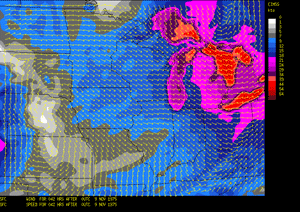Computer model recreates the storm that sank the Edmund Fitzgerald

Surface wind speed (knots) and direction from a CRAS model simulation of the Edmund Fitzgerald Storm valid 12:00 PM CDT, November 10, 1975, approximately seven hours before the last communication with the ship. Northwesterly gale force winds (34 to 40 knots, in red) are indicated in the eastern Lake Superior region where the ship was lost.
MADISON — On Nov. 10, 1975, Lake Superior swallowed the Edmund Fitzgerald, along with her 29 crewmembers and cargo of almost 26,000 tons of ore. The wreck evolved into a Midwestern legend. Thirty years later, researchers at the University of Wisconsin-Madison have recreated the storm using the latest forecast technology.
November storms tend to roll across the Great Lakes, gathering strength and fury. The one that sank the Fitzgerald was no exception. Simulations of weather events like this allow scientists to identify and study characteristics of severe storms. Looking back also helps forecasters and weather modelers improve severe weather prediction techniques.
Robert Aune, a scientist with the National Oceanic and Atmospheric Administration (NOAA) stationed at the University of Wisconsin-Madison Space Science and Engineering Center (SSEC), recently created a simulation of the storm that swept across Lake Superior on that November evening.
Satellite technology was brand new in 1975, so Aune obtained conventional observations through an ongoing project at the National Center for Environmental Prediction and the National Center for Atmospheric Research that uses modern techniques and technology to reanalyze weather data from 1949 through the present.
Aune plugged reanalyzed data from November 8-11, 1975 into a model in operation at Madison’s Cooperative Institute of Meteorological Satellite Studies (CIMSS). The model uses atmospheric observations from several different instruments, including those aboard satellites, to produce weather forecasts.
Aune says these models normally require satellite data, so the biggest challenge was in building this model from other data sources. The effort has broader potential, he says: “Running retrospective cases like this — especially on extreme events — is a good exercise to see if we can reproduce features of a particular storm that happened years ago.”
Besides validating the CRAS research model, Aune’s case study will be used to teach fundamental winter storm dynamics in Professor Steve Ackerman’s basic meteorology course in Madison.
Here’s a simulation of the storm that sank the Edmund Fitzgerald:
http://cimss.ssec.wisc.edu/model/cras61_EF/cras61_EF.html
In addition, a case study of Nov. 10, 1975 weather conditions by meteorology professor Steve Ackerman can be found here:
http://cimss.ssec.wisc.edu/wxwise/fitz.html
###
